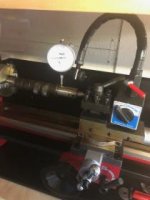Hi all, I'm a beginner so please forgive me if this is an easy problem, but I'd appreciate some help.
I have a camshaft from a motorcycle and the tip has a thread which engages the timing advance mechanism. This tip has become bent (don't ask). I think I can fix this by facing it and tapping a new small hole on my minilathe HOWEVER, I would like to be sure that the camshaft itself isn't bent from the force that bent the tip.
I have tried to measure this by putting it in the lathe and using a dial gauge as shown and there is some variation as I turn the chuck by hand however I feel that this could well be due to the piece not being straight in the chuck. Does anyone have any better ideas to accurately measure this?
Please note that if I was to actually turn this I would use some kind of lathe steady with a bearing.
Thanks!
george

I have a camshaft from a motorcycle and the tip has a thread which engages the timing advance mechanism. This tip has become bent (don't ask). I think I can fix this by facing it and tapping a new small hole on my minilathe HOWEVER, I would like to be sure that the camshaft itself isn't bent from the force that bent the tip.
I have tried to measure this by putting it in the lathe and using a dial gauge as shown and there is some variation as I turn the chuck by hand however I feel that this could well be due to the piece not being straight in the chuck. Does anyone have any better ideas to accurately measure this?
Please note that if I was to actually turn this I would use some kind of lathe steady with a bearing.
Thanks!
george



